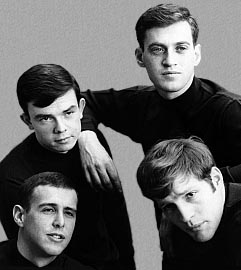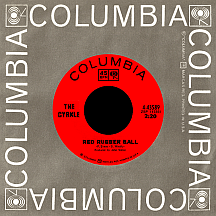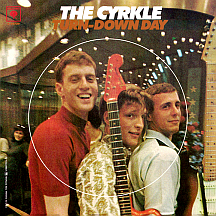THE CYRKLE
Red Rubber Ball
It's surprising The Cyrkle was broken so soon, considering the band's superstar connections and some career breaks to die for. Core members Tom Dawes of Brooklyn, New York and Don Dannemann of upstate Albany met while attending Lafayette College, a private school in Easton, Pennsylvania, and formed The Rondells in 1962 with drummer Jim Maiella and keyboard player Earl Pickens as a folk-rock group doing mostly covers of the era's hits. Don played guitar and did the main vocals, while Tom, more well-rounded with stringed instruments, sang harmony. In 1965, showbiz lawyer Nat Weiss spotted the group in Atlantic City and a single for ABC-Paramount resulted. The quick-paced "Parking in the Kokomo" fit right in with the surf-rock sound of, perhaps, a year earlier, an inconspicuous debut for the soon-to-be avant-garde act.
There were several groups already established with various spellings of the name. Boston-area band The Rondels had an instrumental hit on Amy, "Back Beat No. 1," in '61, a different instrumental group with the same name rocked "On the Run" for Dot Records in '64, The Ron-Dels, a band from Texas led by Delbert McClinton, hit the charts on Smash in '65 with "If You Really Want Me To, I'll Go," late-'60s hitmakers Bill Deal and the Rhondels emerged around that time, and there were others. A fresh, less-dated moniker was in order for Tom and Don, one they could claim excusively. A famous celebrity ("...more popular than Jesus!") came up with a groovy, disc-like suggestion.
Weiss was tight with Brian Epstein and had begun handling some of the stateside promotional affairs of his top act, The Beatles. Seems John Lennon came up with "Cyrkle" (misspelled much like "beetles" had become "Beatles" or "y" replaced "i" in The Byrds)...or so the story has been handed down. With record labels on the lookout for Beatles-styled acts, Weiss had the newly-christened Cyrkle record an audition tape. Two new members, keyboardist Michael Losekamp and drummer Marty Fried, had replaced Pickens and Maiella by then. During some downtime, Tom Dawes toured as bassist for Simon and Garfunkel, who had split after several years together...until Paul Simon, who'd spent some time in England, rushed back home after learning he and former/future partner Art Garfunkel were headed for number one with a studio-enhanced version of their folk song "The Sounds of Silence" that had been released without their knowledge. While on tour, Simon played some tunes for Dawes that he'd written with Bruce Woodley of the popular U.K. group The Seekers, including "Red Rubber Ball" and "I Wish You Could Be Here."
Things quickly fell into place when the Cyrkle landed a contract with Columbia, Epstein became their manager, and "Red Rubber Ball" (produced by soon-to-be-hot producer John Simon, no relation to Paul) bounced to number two on the charts in July. Tom's claim was that Paul had given him the song to record (at a concert the following year, Art told the crowd, "The Cyrkle beat us to it" just before S&G launched into a folky, acoustic version). At any rate, the Cyrkle scored one of the top hits of summer '66, which led to an opportunity of a lifetime: Epstein put them on the bill of the Beatles' August tour of the U.S., along with Bobby Hebb, The Ronettes and The Remains, an 18-day whirlwind that began August 12th in Chicago and wrapped up on the 29th in San Francisco at the home of the Giants, Candlestick Park. As it turned out, the show was the last concert the Fab Four ever did (spur-of-the-moment rooftop jam sessions notwithstanding)...and the Cyrkle was...well, part of the inner circle.

"Turn-Down Day," a song penned by jazz pianist Dave Blume and "Here Comes Summer" singer Jerry Keller that's not as much of a bummer as the title suggests, was climbing the charts as the surreal Candlestick event spun spherically around the heads of the performing Cyrkle that day in late August; the single peaked in the top 20 the following month. There was no reason the band's light-rock style shouldn't have spawned more hits, yet the hot, hectic summer of '66 stands as the band's peak. "Please Don't Ever Leave Me," written by Susan Haber, was maybe a bit too melancholic; it peaked mid-chart at the end of the year. The aforementioned Simon-Woodley song "I Wish You Could Be Here" has an ethereal appeal, but was even less successful. "Camaro," a promotional single handed out at Chevrolet dealerships, turned the Cyrkle sound on its ear (its flip side, "SS 396" by Paul Revere and the Raiders, had been issued as a similar Chevy tie-in two years earlier).
Songwriting stars past and present stepped up to supply material for the band. "We Had a Good Thing Goin'," a Neil Sedaka-Howard Greenfield ditty, leaned slightly more psychedelic (using a weirdly-compelling, seldom-heard vari-speed trick). Sandy Linzer and Denny Randell (who'd scored with some big 4 Seasons hits) contributed "Penny Arcade" and the band picked up a Robin Gibb-Barry Gibb song, "Turn of the Century," for a late-'67 release coming just as Gibb group The Bee Gees wrapped the first of many top-tier years on the U.S. charts. Despite the high quality of these recordings, each Cyrkle single sold less than its predecessor. By early 1968, radio airplay was nonexistent other than recurrent spins of the band's two big hits.
Tom and Don composed the soundtrack music, performed by the Cyrkle, for Squeeze Play, a film directed by Raymond Jacobs that starred once-popular actress Jan Sterling, a decade or so past her prime. The movie sat on the shelf; scenes with nudity were added and this X-rated version made it to theaters in late 1969 under a new title, The Minx (one of the songs on the soundtrack), coming nearly two years after The Cyrkle had broken up. Tom Dawes and Don Dannemann, perhaps inspired by the "Camaro" song and its commercial possibilities, embarked on separate careers writing jingles for television commercials.



